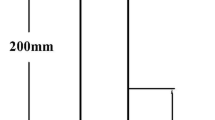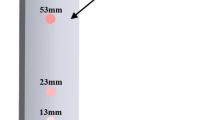Abstract
The influence of quench transfer time on the microstructure and mechanical properties of 7055 aluminum alloy with and without zirconium was investigated by tensile properties test, optical microscopy, scanning electron microscopy and transmission electron microscopy. For the Zr-free alloy, the strength increases to the highest value at 20 s with transfer time, and then decreases slightly. The elongation decreases slowly with transfer time within 20 s, and more rapidly after 20 s. For the Zr-containing alloy, prolonging transfer time within 20 s results in slight decrease in the strength and elongation, and rapid drop of which is observed after 20 s. For the Zr-free alloy, prolonging transfer time can increase the percentage of intergranular fracture, which is mainly caused by wide grain boundary precipitate free zone. The failure mode of the Zr-containing alloy is modified from the predominant transgranular void growth and intergranular fracture to transgranular shear and intergranular fracture with increase in the transfer time, which is attributed to the wider grain boundary precipitate free zone and coarse equilibrium η phases in the matrix.
Similar content being viewed by others
References
WILLIAMS J C, STARKE E A Jr. Progress in structural materials for aerospace systems[J]. Acta Materialia, 2003, 51(19): 5775–5799.
DUMONT D, DESCHAMPS A. Characterization of precipitation microstructures in aluminium alloys 7040 and 7050 and their relationship to mechanical behavior[J]. Materials Science and Technology, 2004, 20(5): 567–576.
DESCHAMPS A, BRÉCHET C. Nature and distribution of quench-induced precipitation in an Al-Zn-Mg-Cu alloy[J]. Scripta Materialia, 1998, 39(11): 1517–1522.
LIM S T, YUN S J, NAM S W. Improved quench sensitivity in modified aluminum alloy 7175 for thick forging applications[J]. Materials Science and Engineering A, 2004, 371(1/2): 82–90.
JEREMY S R, CUDD R L, TANNER D A, DOLAN G P. Quench sensitivity and tensile property inhomogeneity in 7010 forgings[J]. Journal of Materials Processing Technology, 2001, 119(1/3): 261–267.
LIU Sheng-dan, ZHANG Xin-ming, HUANG Zhen-bao, DU Yu-xuan. Effects of solution heat treatment on microstructure in a high-purity 7055 aluminum alloy[J]. Trans Mater Heat Treat, 2006, 27(3): 54–59. (in Chinese)
CHEN K H, LIU H W, ZHANG Z, LI S, TOOD R I. The improvement of constituent dissolution and mechanical properties of 7055aluminum alloy by stepped heat treatments[J]. Journal of Materials Processing Technology, 2003, 142(1): 190–196.
LI Hai, ZHENG Zhi-qiao. Retrogression and reaging of Ag-containing 7055 Al alloy[J]. Rare Metal Materials and Engineering, 2004, 33(7): 718–722. (in Chinese)
LIU Sheng-dan, ZHANG Xin-ming, HUANG Zhen-bao, LIU Wen-hui. Quench sensitivity of 7055 aluminum alloy[J]. Journal of Central South University: Science and Technology, 2006, 37(5): 846–849. (in Chinese)
ROBSON J D, PRANGNELL P B. Predicting the recrystallized volume fraction in AA7050 hot rolled plate[J]. Materials Science and Technology, 2002, 18(6): 607–619.
ENGLER O, SACHOT E, EHRSTRÖM J C. Recrystallization and texture in hot deformed aluminium alloy 7010 thick plates[J]. Materials Science and Technology, 1996, 12(9): 717–729.
THOMPSON D S, SUBRAMANYA B S, LEVY S A. Quench rate effects in Al-Zn-Mg-Cu alloys[J]. Metallurgical Transactions, 1971, 2(4): 1149–1160.
HIROSAWA S, OGURI Y, SATO T. Formation mechanism of precipitate free zones in age-hardenable Al alloys[J]. Materials Forum, 2004, 28: 666–671.
DORWARD R C, BEERNTSEN D J. Grain structure and quench-rate effects on strength and toughness of AA7050 Al-Zn-Mg-Cu-Zr alloy plate[J]. Metallurgical and Materials Transactions A, 1995, A26(9): 2481–2484.
de HAAS M, DE HOSSON J T M. On the effects of thermomechanical processing on failure mode in precipitation-hardened aluminium alloys[J]. Journal of Materials Science, 2002, 37(23): 5065–5073.
Author information
Authors and Affiliations
Corresponding author
Additional information
Foundation item: Project(2005CB623706) supported by the Major State Basic Research Development Program of China; Project(50230310) supported by the National Natural Science Foundation of China
Rights and permissions
About this article
Cite this article
You, Jh., Liu, Sd., Zhang, Xm. et al. Influence of quench transfer time on microstructure and mechanical properties of 7055 aluminum alloy. J. Cent. South Univ. Technol. 15, 153–158 (2008). https://doi.org/10.1007/s11771-008-0030-y
Received:
Accepted:
Published:
Issue Date:
DOI: https://doi.org/10.1007/s11771-008-0030-y




